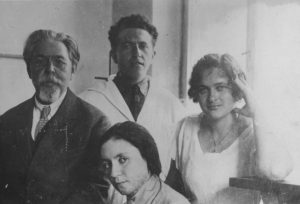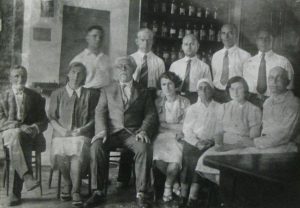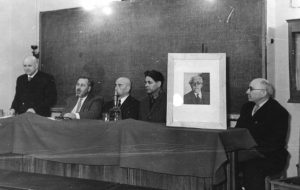
(1879-1938)
Russian process engineer, professor, renowned expert in theoretical and applied catalysis, basic chemical technology. After 1917, he took an active part in the restoration and development of the chemical industry, building new plants in Ukraine. He studied the theoretical foundations of catalysis and the kinetics of chemical reactions. He studied the mechanism of oxidation of sulphur (IV) oxide and ammonia; together with G.K. Boreskov he proposed a vanadium catalyst for the oxidation of SO2 in the production of sulphuric acid. He discovered the fundamentals of a new method of producing H2SO4 by oxidation of wet gas; the physicochemical basis for the production of HCN from CH4 and NH3; and proposed a theory of ammonia oxidation. He wrote the textbook Nitric Acid in Russian and Ukrainian (1934).
Ivan Yevhrafovych Adadurov (19.12.1879 – 26.08.1938) was born in the town of Snovske, Chernihiv region. His great-grandfather was a professor of mathematics at Moscow University, and his grandfather was a theatre director in Leningrad. Ivan Yevgrafovich’s father was a railway engineer.
Initially, Ivan Yevgrafovych studied in Moscow, but in 1899 he was arrested for participating in the student revolutionary movement and spent 5 months in exile in Kirzhach. After that, he continued his studies and graduated from the Warsaw Polytechnic Institute. He then worked in various engineering positions, improving his knowledge and gaining practical experience. His first scientific paper “On the Origin of Oil” was published in 1902 (when he was 23 years old) in the journal “Chemist”.
After 1917, I.E. Adadurov took an active part in the restoration and development of the chemical industry, building new plants. His activities during this period resulted in the restoration of the sulphuric acid plant, caustic soda shop, bertolet salt shop, and NaCl electrolysis shop in Ivashchenkovo; the construction of mirror, bottle, and glass plants in Konstantinovka; and the construction of contact production shops for sulphuric acid, zinc whitewash, and sodium sulphate at the Konstantinovka Chemical Plant – a total of 25 large industrial facilities. And in these difficult factory conditions, with extensive administrative responsibilities, I.E. Adadurov found time to conduct research and publish his scientific articles.
The full flowering of Ivan Evgrafovich’s creative abilities began in 1928 at the age of 50, when he was appointed head of the Department of Mineral Technology at the Odesa Institute of Chemical Technology, and in 1933 he became head of the Department of Mineral Technology at the Kharkiv Institute of Chemical Technology. He also taught a course on catalysis at Kharkiv University. He was awarded the title of professor, and on 11 May 1937, the Higher Attestation Commission awarded I.E. Adadurov the degree of Doctor of Technical Sciences without defending his dissertation.

Using various approaches to the selection of catalysts, he studied hundreds of metals, alloys, oxides, salts and carriers. By studying their activity, he tried to find out the regularity in the selection and preparation of catalysts. He investigated the mechanism of SO2 and NH3 oxidation reactions; the activity of new catalysts, poisoning, their duration of action, durability and losses. He found optimal technological conditions, improved contact devices, and developed methods for their calculation. Ivan Evgrafovich was a scientist who studied the catalytic process comprehensively, taking into account all the requirements.
I.E. Adadurov formulated his point of view on heterogeneous catalysis many times. In his opinion, the essence of the catalytic effect of a solid on the molecules of the reaction components to be catalysed is reduced to the deforming effect of the surface field, which transfers the molecules to an active, reactive state. However, in order for such an act of deformation to occur, it is necessary, firstly, that the deforming force of the field is sufficient to transfer the molecules to the active state and, secondly, that the fields of the corresponding active sites (edges, angles of excitation, lattice nodes) are associated with the fields of the catalysed molecules, i.e., have the necessary and defined state, shape and surface energy.

I.E. Adadurov pointed out that the catalytic process is the result of the interaction of the external field of the catalyst and the internal field of the molecule. Taking this into account, he established, using the hydrogenation of ortho- and paranitrotoluene as an example, that the higher the Kerr constant, which characterises the ability of a molecule to polarise, the lower the activation energy. The relationships he established made it possible to determine the activation energy of the hydrogenation reaction of meta- and paranitrotoluene using the Kerr constant and the activation energy of orthonitrotoluene.
For some time, Ivan Evgrafovich was a great supporter of the radiation theory of catalysis. In his studies on the thermal decomposition of sodium chloride and potassium chloride in the presence of a catalyst, he compared the wavelengths that can transfer an electron during the decomposition of a compound from anion to cation with the wavelength of the element being catalysed. A catalyst selected according to the wavelength of light that performs a given photochemical reaction reproduces the same effect and in the same direction as the light wave, giving a reaction with the same reaction order. He established the law that the product of wavelength (angstrom) and absolute temperature is a constant. The result was the identification and experimental confirmation of the catalytic elements Cu, Mo, Fe, W, Mn, Co, Zn and the corresponding reaction temperatures for the decomposition of sodium chloride.
Ivan Evgrafovich was one of the first to raise the question of the influence of the shape and size of the contact mass on the catalytic process. The correct choice of the size and shape of the catalytic mass will determine the geometric specific surface area of shielding and heat removal. Using the example of sulphur dioxide oxidation, he and his colleagues demonstrated the strong dependence of the reaction rate on the size and shape of the catalyst. Further development of research in this area later made it possible to determine the particle size at which the reaction takes place in the kinetic or diffusion region.
I.E. Adadurov studied the effect of carriers on the sintering of catalysts using the example of ethylene hydrogenation on nickel. Be, Mg, Ca, Sr, Ba sulphates with different ion radii were used as carriers. It was found that with an increase in the radius of the divalent cation, the sintering decreases and the activity of the deposited nickel on the substrate increases. It has been shown that catalysis by molten metals at the melting point causes a sharp decrease in catalytic activity. The specific surface area of such catalysts is small.
In his opinion, the degree of metal coverage of the carrier surface affects the activity of the catalyst, and thereby the activation energy of the reaction it accelerates. Although P.Y. Ivannikov raised objections to the latter, Ivan Evgrafovich’s concepts deserve attention.
Ivan Evgrafovich’s research in the field of theory and technology of ammonia oxidation is well known. Together with his colleagues, he studied alloys of platinum with rhodium, tungsten, cobalt, silver, chromium and other metals as a catalyst for the oxidation of ammonia to nitrogen (II) oxide. He found that those alloys in which the lattice constant remained unchanged or close to the lattice constant of platinum, equal to 3.903 A, would be active. Important research was conducted to find nonplatinum catalysts for the oxidation of NH3.
Ivan Evgrafovich proposed the theory of ammonia oxidation, which, along with many others, explains the mechanism of formation of nitric oxide from ammonia. He believed that the primary act on the catalyst is the decomposition of ammonia to form N, H and H2. Further, a homogeneous-heterogeneous chain reaction is possible.
These studies are complemented by research conducted by I.E. Adadurov and his colleagues on the oxidation of a mixture of ammonia and methane to produce hydrogen cyanide. They studied the physicochemical conditions of hydrocyanic acid production, which resulted in a yield of up to 65%. All these data formed the basis of the modern method of hydrocyanic acid production.
When Ivan Evgrafovich studied platinum-rhodium nets for the contact oxidation of ammonia, he came to the conclusion that the main reason for their destruction was the reduction of hydrogen, which was formed during the conversion of NH3 to NO, to a strong oxide film on the surface, which prevents crystals from coming to the catalyst surface. Hydrogen penetrates the crystal lattice of platinum and forms platinum hydrides, which are easily sublimated. By introducing a number of other non-hydrogen-absorbing metals, such as tungsten, silver and chromium, into platinum or rhodium during ammonia oxidation, the surface degeneration of the platinum grid can be reduced and its strength can be increased. If rhodium acts as an oxidising agent, the catalytic activity will also increase.

In order to reduce the loss of platinum as a catalyst in the oxidation of ammonia, Ivan Evgrafovich studied platinum nets. He and his colleagues studied platinum, nickel, copper, silver and other nets. He believed that the inner layer of platinum nets was a carrier and that only a thin, surface layer of platinum had a catalytic effect. However, the swelling of the inner wire and the gradual loosening of the surface layer of platinum caused an increase in costs. Platinum-coated chromium-nickel carriers for sulphur dioxide oxidation proved to be the best.
Ivan Evgrafovich conducted more than 20 studies to improve sulphuric acid production technology, 6 studies to intensify nitric acid production, and 13 studies on the technology of producing various salts. At his suggestion, lead pipes in the sulphuric acid production area were replaced by iron and cast iron pipes using the nitrosation process.
It should be noted that I.E. Adadurov had the courage of a scientific researcher to abandon the views he expressed at an early stage of his research if they were not confirmed. This was the case with his conclusion about the possibility of direct oxidation of ammonia to nitric oxide (V) and nitric acid, which he had expressed on the basis of an imperfect research method.
Much credit goes to I.E. Adadurov for translating monographs into Russian: Schwab’s Physicochemical Basics of Chemical Technology, Hinshelwood’s Kinetics of Reactions in Gaseous Systems, Sauter’s Heterogeneous Catalysis, Schwab’s Catalysis from the Point of View of Chemical Kinetics, and others. He translated or edited 8 important monographs for science.
Ivan Yevgrafovych co-authored with his students the textbook Nitric Acid (1934) and a little earlier a Ukrainian edition of the same title.
He was one of the organisers and leaders of the Mendeleev Congress held in Kharkiv in 1932. Here he chaired a section and made several presentations. Out of 163 papers published by him, 36 were published in the Journal of Applied Chemistry, 26 in the Journal of Chemical Industry, and 16 in the Ukrainian Chemical Journal.
The inseparable connection between scientific work and the organisation of the educational process for the training of engineering and scientific personnel, carried out by I.E. Adadurov, is well known. Always cheerful and vigorous, he delivered his lectures with enthusiasm and conviction. Ivan Evgrafovich informed his students of everything new that appeared in publications, new thoughts in the field of basic chemical industry, and his scientific papers also became the property of students.
I.E. Adadurov never separated teaching from research. All faculty and staff were involved in scientific work at the department. During his teaching career, Ivan Yevgrafovych trained hundreds of specialists in basic chemistry.
In June 1938, the director of the Kharkiv Institute of Chemical Technology, Professor I.I. Strelkov, received a letter from the deputy chairman of the All-Union Committee for Higher Education under the USSR Council of People’s Commissars A. SukhanovThe Committee on Higher Education for the second time proposes to second Professor Adadurov, who is known to have expressed a personal desire to work at Leningrad Red Banner Institute of Chemical Technology. Professor Adadurov was elected to the post of Head of the Department of Inorganic Production.”
After that, it was repeatedly proposed to the management of the KHTI to formalise the transfer of Professor I.E. Adadurov to the Leningrad Institute of Chemical Technology in accordance with his personal desire. On 26 July 1938, by order of the USSR Council of People’s Commissars, Professor I.E. Adadurov was dismissed from the position of Head of the Department of Inorganic Substances Technology of the KCTI and approved as Head of the Department of Inorganic Production Technology of the LCTI.
However, Professor I.E. Adadurov did not have time to start his planned new major work at the Leningrad Institute of Chemical Technology. On the first of September 1938, from the Leningrad hotel “Europe”, Ivan Yevgrafovych’s wife wrote a letter to Prof. Strelkov:
“Dear and deeply respected Ilya Ivanovich! It is difficult to express how much grief I am experiencing right now. My personal situation is extremely difficult. I am currently living in a hotel, and my belongings are in a warehouse at the railway station. On the 13th of August, he had an attack of appendicitis at night and underwent surgery at 1pm, and lived until the 26th of August in hospital in a serious condition, and at 2pm he stopped breathing. All this was happening right before my eyes. It’s hard to put my feelings into words…
…No wonder I did not want to go to this gloomy city for a long time. It is very beautiful, but I do not see it except for Ivan Evgrafovich’s grave…”
Before Professor I.E. Adadurov could begin his scientific work at the Leningrad Institute of Chemical Technology, he died suddenly at the age of 59.
Over the 10 years of his career, Ivan Evgrafovich Adadurov made a major contribution to the development of catalysis science and chemical technology. Many of his ideas were developed by his students and followers and became the property of our country.
